Urban Wind Resource Assessment: A Case Study on Cape Town
Abstract
:1. Introduction
1.1. Current Status of Urban Wind Energy
1.2. Weibull Probability Distributions
1.3. Impact of Urban Environment of Wind Flow
2. Methodology
- Wind Measurements: Wind speed measurements from the South African Weather Service.
- Data Pre-Processing: Sorting and transforming data into necessary formats (using Excel).
- Data Analysis: Analyze wind resource potential (adapted from “bReeze” [24]).
- Calculating AEPs: Combine wind resource results with SWT power curves to obtain AEP.
2.1. Measurement Locations and Data
2.2. SWT Models
2.3. Expected Diurnal Electricity Generation
2.4. Cost of Electricity
3. Results
3.1. Analysis Procedure: Demonstration using WO Station
3.2. Results for All Stations
3.2.1. Comparison of Wind Turbines
3.2.2. Expected Diurnal Electricity Generation
3.2.3. Cost of Electricity
4. Discussion
4.1. Quantification of the Urban Wind Potential in Cape Town
4.2. Comparison of the Different Wind Turbine Types
4.3. Daily Electricity Generation
4.4. Cost-Effectiveness of a Small-Scale Wind Turbine in Cape Town
4.5. Viability Small-Scale Wind Turbine in Cape Town
5. Conclusions
Author Contributions
Funding
Acknowledgments
Conflicts of Interest
Abbreviations
| AEP | Annual Energy Production |
| AWS | Automatic Weather Station |
| IEC | International Electrotechnical Commission |
| HAWT | Horizontal Axis Wind Turbine |
| KIR | Kirstenbosch Botanical Gardens |
| LCOE | Levelized Cost of Electricity |
| MOL | Molteno Reservoir |
| OBS | South African Astronomical Observatory |
| PV | Photovoltaic |
| RCYC | Royal Cape Yacht Club |
| REIPPPP | Renewable Energy Independent Power Producer Procurement Program |
| RMSE | Root Mean Square Error |
| SAWS | South African Weather Services |
| SWT | Small-(Scale) Wind Turbine |
| UWE | Urban Wind Energy |
| VAWT | Vertical Axis Wind Turbine |
| WO | Cape Town Weather Office |
References
- Syngellakis, K.; Carroll, S.; Robinson, P. Small Wind Power: Introduction to Urban Small Scale Wind in the UK. Refocus 2006, 7, 40–45. [Google Scholar] [CrossRef]
- Palma, J.M.L.M.; Castro, F.A.; Ribeiro, L.F.; Rodrigues, A.H.; Pinto, A.P. Linear and Nonlinear Models in Wind Resource Assessment and Wind Turbine Micro-Siting in Complex Terrain. J. Wind Eng. Ind. Aerodyn. 2008, 96, 2308–2326. [Google Scholar] [CrossRef]
- Lotfi, M. Atmospheric Wind Flow Distortion Effects of Meteorological Masts. Master’s Thesis, FEUP, Porto, Portugal, 2015. [Google Scholar]
- Walker, S.L. Building Mounted Wind Turbines and Their Suitability for the Urban Scale—A Review of Methods of Estimating Urban Wind Resource. Energy Build. 2011, 43, 1852–1862. [Google Scholar] [CrossRef]
- International Electrotechnical Commission. Wind Energy Generation Systems—Part 12-1: Power Performance Measurements of Electricity Producing Wind Turbines; IEC 61400-12-1:2017; International Electrotechnical Commission: Geneva, Switzerland, 2017. [Google Scholar]
- Pope, S.B. Turbulent Flows; Cambridge University Press: Cambridge, UK, 2000. [Google Scholar]
- Patankar, S.V. Numerical Heat Transfer and Fluid Flow; CRC Press: Boca Raton, FL, USA, 1980. [Google Scholar]
- Simões, T.; Estanqueiro, A. A New Methodology for Urban Wind Resource Assessment. Renew. Energy 2016, 89, 598–605. [Google Scholar] [CrossRef]
- Pitteloud, J.-D.; Gsänger, S. 2016 Small Wind World Report; WWEA: Bonn, Germany, 2016. [Google Scholar]
- Brosius, W. Feasibility Study for Wind Power at SAB Newlands; University of Stellenbosch: Stellenbosch, South Africa, 2009. [Google Scholar]
- Tummala, A.; Velamati, R.K.; Sinha, D.K.; Indraja, V.; Krishna, V.H. A Review on Small Scale Wind Turbines. Renew. Sustain. Energy Rev. 2016, 56, 1351–1371. [Google Scholar] [CrossRef]
- Karthikeya, B.R.; Negi, P.S.; Srikanth, N. Wind Resource Assessment for Urban Renewable Energy Application in Singapore. Renew. Energy 2016, 87, 403–414. [Google Scholar] [CrossRef]
- Yang, A.-S.; Su, Y.-M.; Wen, C.-Y.; Juan, Y.-H.; Wang, W.-S.; Cheng, C.-H. Estimation of Wind Power Generation in Dense Urban Area. Appl. Energy 2016, 171, 213–230. [Google Scholar] [CrossRef]
- Fields, J.; Oteri, F.; Preus, R.; Baring-Gould, I. Deployment of Wind Turbines in the Built Environment: Risks, Lessons, and Recommended Practices; National Renewable Energy Laboratory: Golden, CO, USA, 2016.
- Green, S.; Bradford, J. Location, Location, Location: Domestic Small-Scale Wind Field Trial Report; The Energy Saving Trust: London, UK, 2009. [Google Scholar]
- International Electrotechnical Commission. Wind Turbines—Part 2: Small Wind Turbines; International Electrotechnical Commission: Geneva, Switzerland, 2013. [Google Scholar]
- Celik, A.N. Energy Output Estimation for Small-Scale Wind Power Generators Using Weibull-Representative Wind Data. J. Wind Eng. Ind. Aerodyn. 2003, 91, 693–707. [Google Scholar] [CrossRef]
- Ayodele, T.R.; Jimoh, A.A.; Munda, J.L.; Agee, J.T. Statistical Analysis of Wind Speed and Wind Power Potential of Port Elizabeth Using Weibull Parameters. J. Energy S. Afr. 2012, 23, 30–38. [Google Scholar]
- Usta, I. An Innovative Estimation Method Regarding Weibull Parameters for Wind Energy Applications. Energy 2016, 106, 301–314. [Google Scholar] [CrossRef]
- Wais, P. A Review of Weibull Functions in Wind Sector. Renew. Sustain. Energy Rev. 2017, 70, 1099–1107. [Google Scholar] [CrossRef]
- Carta, J.A.; Ramírez, P.; Velázquez, S. A Review of Wind Speed Probability Distributions Used in Wind Energy Analysis: Case Studies in the Canary Islands. Renew. Sustain. Energy Rev. 2009, 13, 933–955. [Google Scholar] [CrossRef]
- Barlow, J.F. Progress in Observing and Modelling the Urban Boundary Layer. Urban Clim. 2014, 10, 216–240. [Google Scholar] [CrossRef]
- Stewart, I.D.; Oke, T.R.; Stewart, I.D.; Oke, T.R. Local Climate Zones for Urban Temperature Studies. Bull. Am. Meteorol. Soc. 2012, 93, 1879–1900. [Google Scholar] [CrossRef]
- Graul, C.; Poppinga, C. bReeze: Functions for Wind Resource Assessment version 0.4-3 from CRAN. Available online: https://rdrr.io/cran/bReeze/ (accessed on 24 January 2019).
- Toparlar, Y.; Blocken, B.; Maiheu, B.; van Heijst, G.J.F. A Review on the CFD Analysis of Urban Microclimate. Renew. Sustain. Energy Rev. 2017, 80, 1613–1640. [Google Scholar] [CrossRef]
- South African Weather Service (SAWS). Verification, Conformance and Maintenance Reports for Various Weather Stations; SAWS: Pretoria, South Africa, 2017. [Google Scholar]
- Ramli, N.I.; Ali, M.I.; Syamsyul, M.; Saad, H.; Majid, T.A. Estimation of the Roughness Length (Zo) in Malaysia Using Satellite Image. In Proceedings of the Seventh Asia-Pacific Conference on Wind Engineering, Taipei, Taiwan, 8–12 November 2009. [Google Scholar]
- Wieringa, J. Updating the Davenport Roughness Classification. J. Wind Eng. Ind. Aerodyn. 1992, 4, 357–368. [Google Scholar] [CrossRef]
- Byun, D.W.; Arya, S.P.S. A Two-Dimensional Mesoscale Numerical Model of an Urban Mixed Layer—I. Model Formulation, Surface Energy Budget, and Mixed Layer Dynamics. Atmos. Environ. Part A. Gen. Top. 1990, 24, 829–844. [Google Scholar] [CrossRef]
- Droste, A.M.; Steeneveld, G.J.; Holtslag, A.A.M. Introducing the Urban Wind Island Effect. Environ. Res. Lett. 2018, 13, 094007. [Google Scholar] [CrossRef]
- Jury, M.R.; Diab, R. Wind energy potential in the cape coastal belt. S. Afr. Geogr. J. 1989, 71, 3–11. [Google Scholar] [CrossRef]
- Schumann, E.H.; Martin, J.A. Climatological aspects of the coastal wind field at Cape Town, Port Elizabeth and Durban. S. Afr. Geogr. J. 1991, 73, 48–51. [Google Scholar] [CrossRef]
- Grieser, B.; Sunak, Y.; Madlener, R. Economics of Small Wind Turbines in Urban Settings: An Empirical Investigation for Germany. Renew. Energy 2015, 78, 334–350. [Google Scholar] [CrossRef]
- WindPower. WindPower Program, UK Wind Speed Database Program and Turbine Power Curve Database. Available online: http://www.wind-power-program.com/download.htm#database (accessed on 24 January 2019).
- Bandi, M.; Apt, J. Variability of the Wind Turbine Power Curve. Appl. Sci. 2016, 6, 262. [Google Scholar] [CrossRef]
- Energy Information Administration (EIA). Levelilzed Cost and Levelized Avoided Cost of New Generation Resources in the Annual Energy Outlook 2017; EIA: Washington, DC, USA, 2017.
- Department of Energy Republic of South Africa. Integrated Resource Plan Update: Assumptions, Base Case Results and Observations; Department of Energy Republic of South Africa: Pretoria, South Africa, 2016.
- European Central Bank. Eurosystem Policy and Exchange Rates. Available online: https://www.ecb.europa.eu/stats/policy_and_exchange_rates/html/index.en.html (accessed on 4 December 2018).
- Almukhtar, A.H. Effect of Drag on the Performance for an Efficient Wind Turbine Blade Design. Energy Procedia 2012, 18, 404–415. [Google Scholar] [CrossRef]
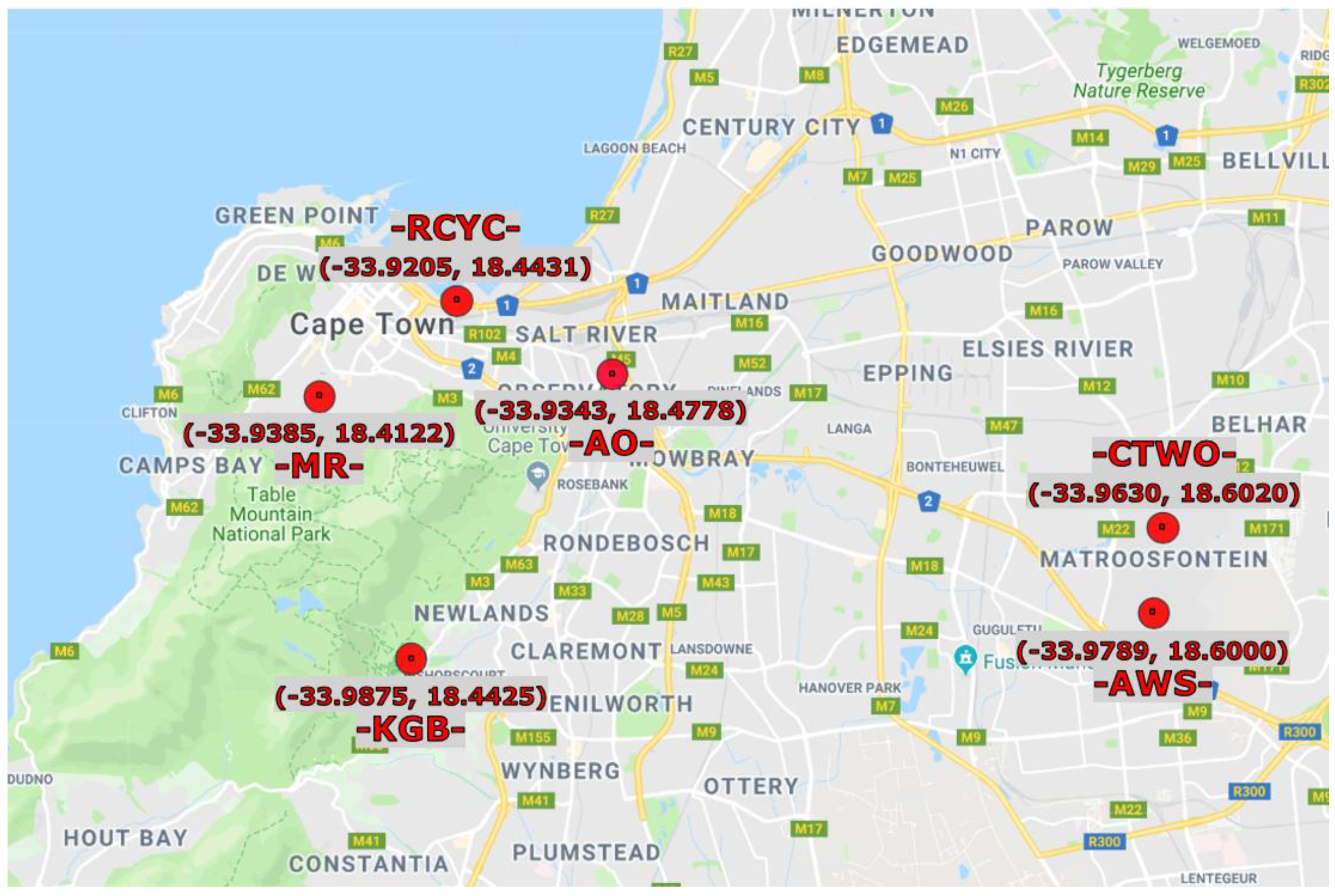
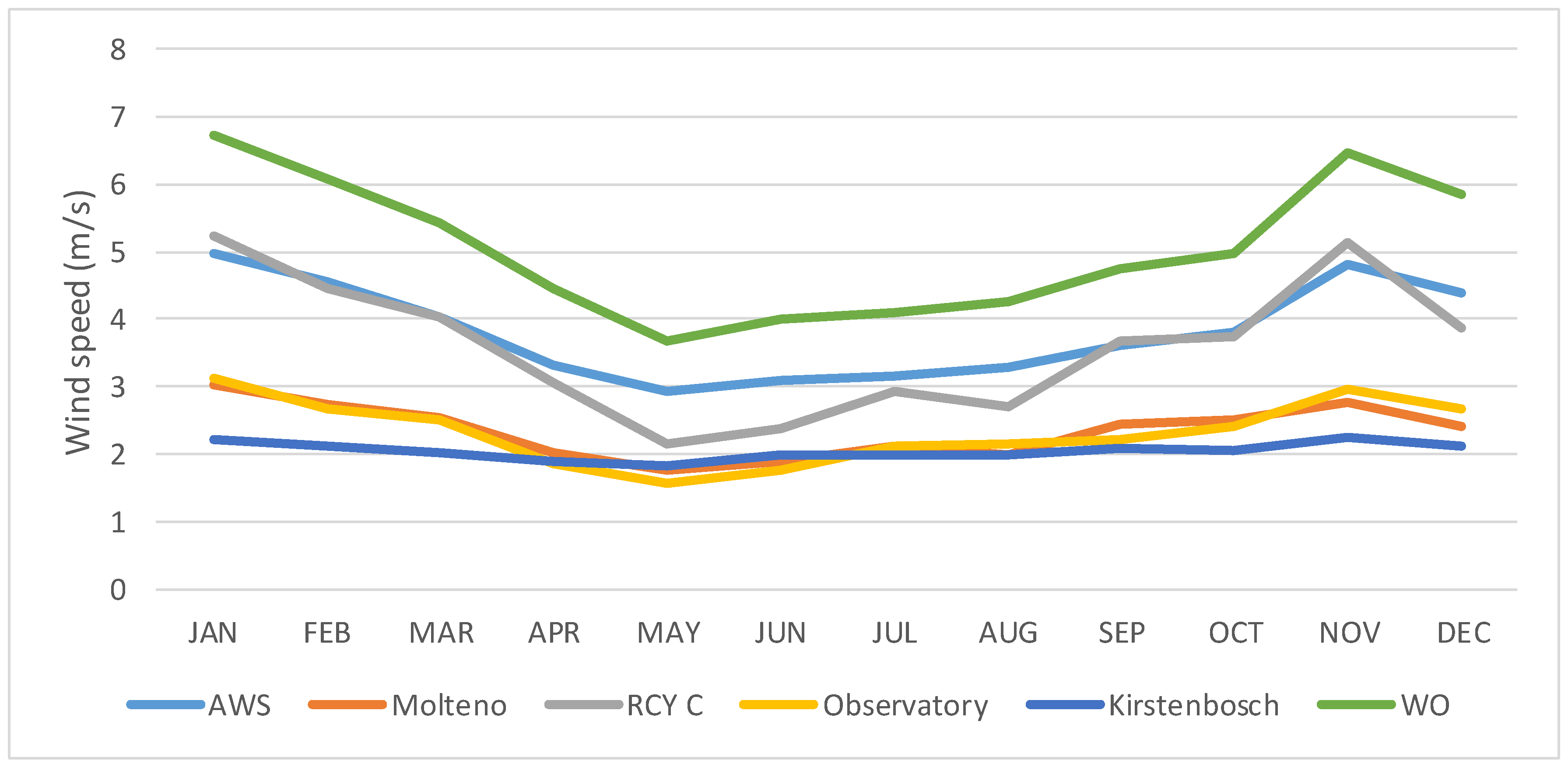

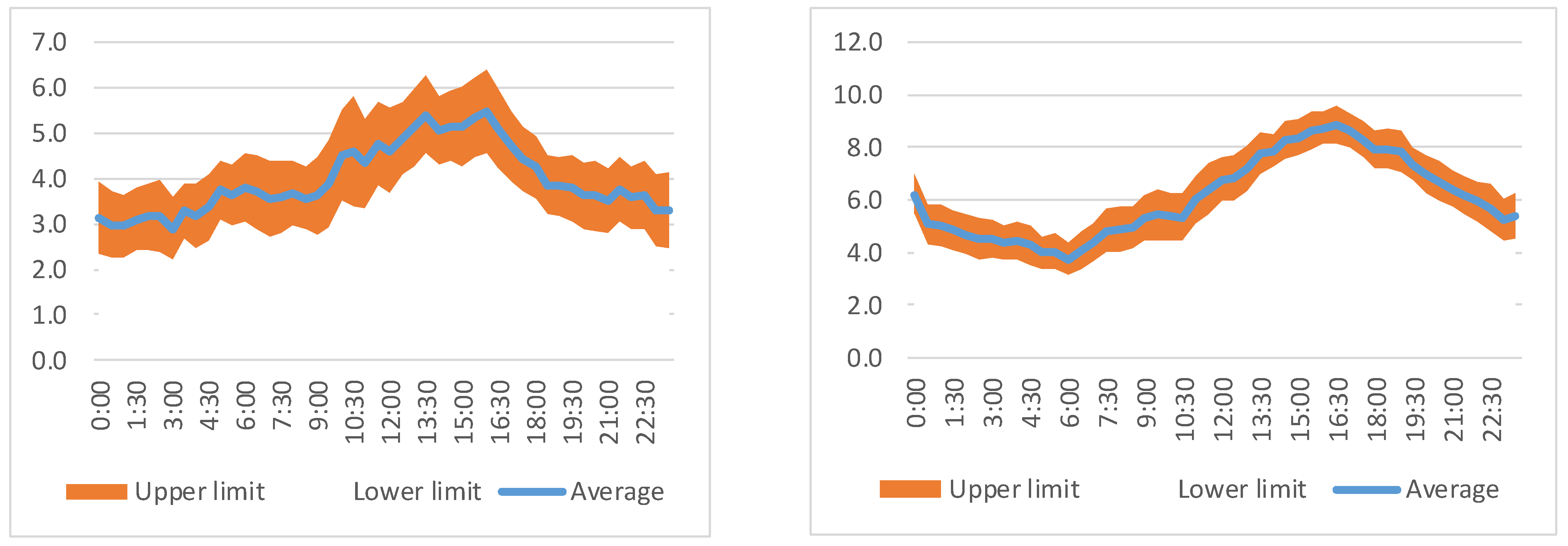
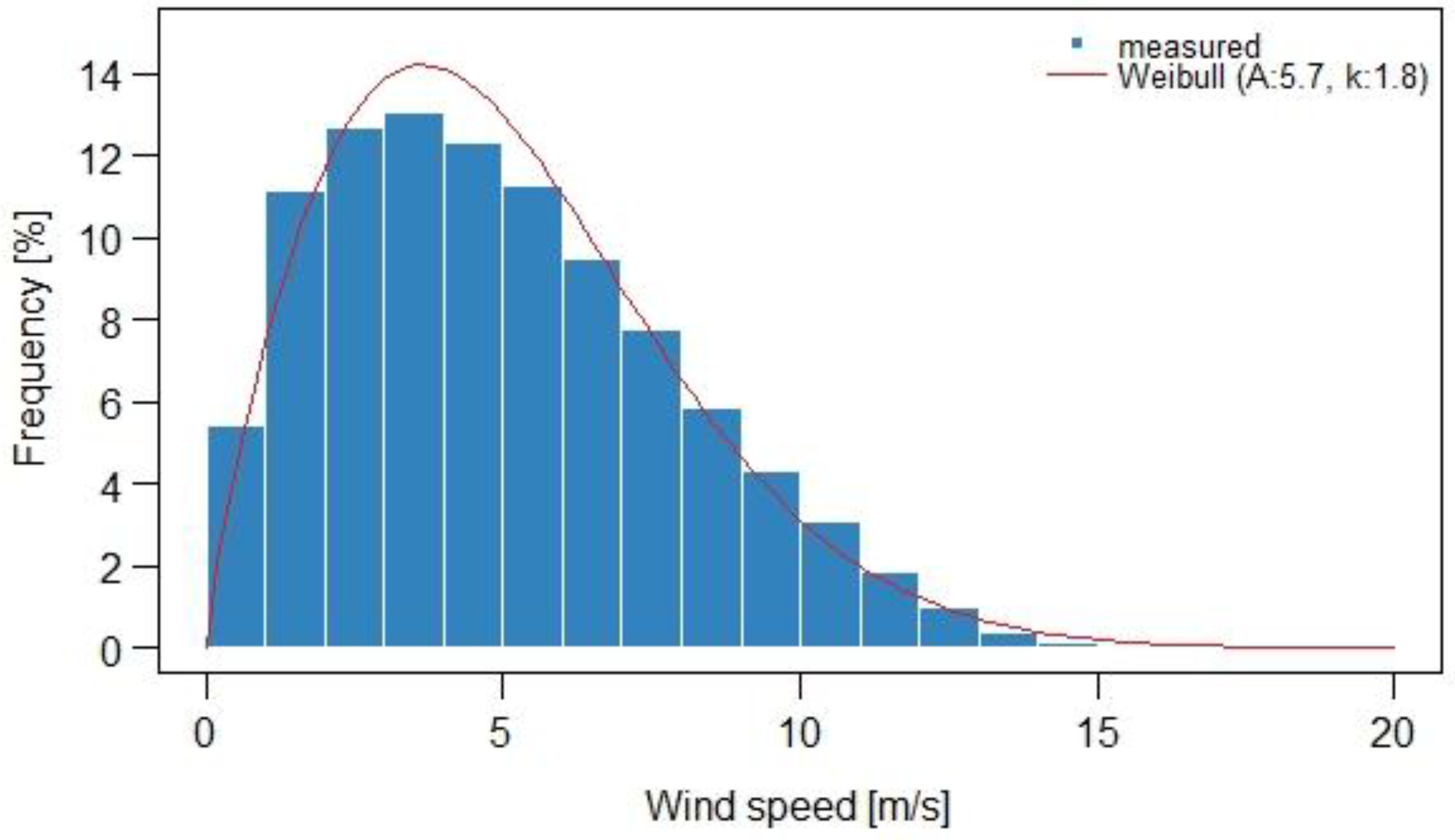

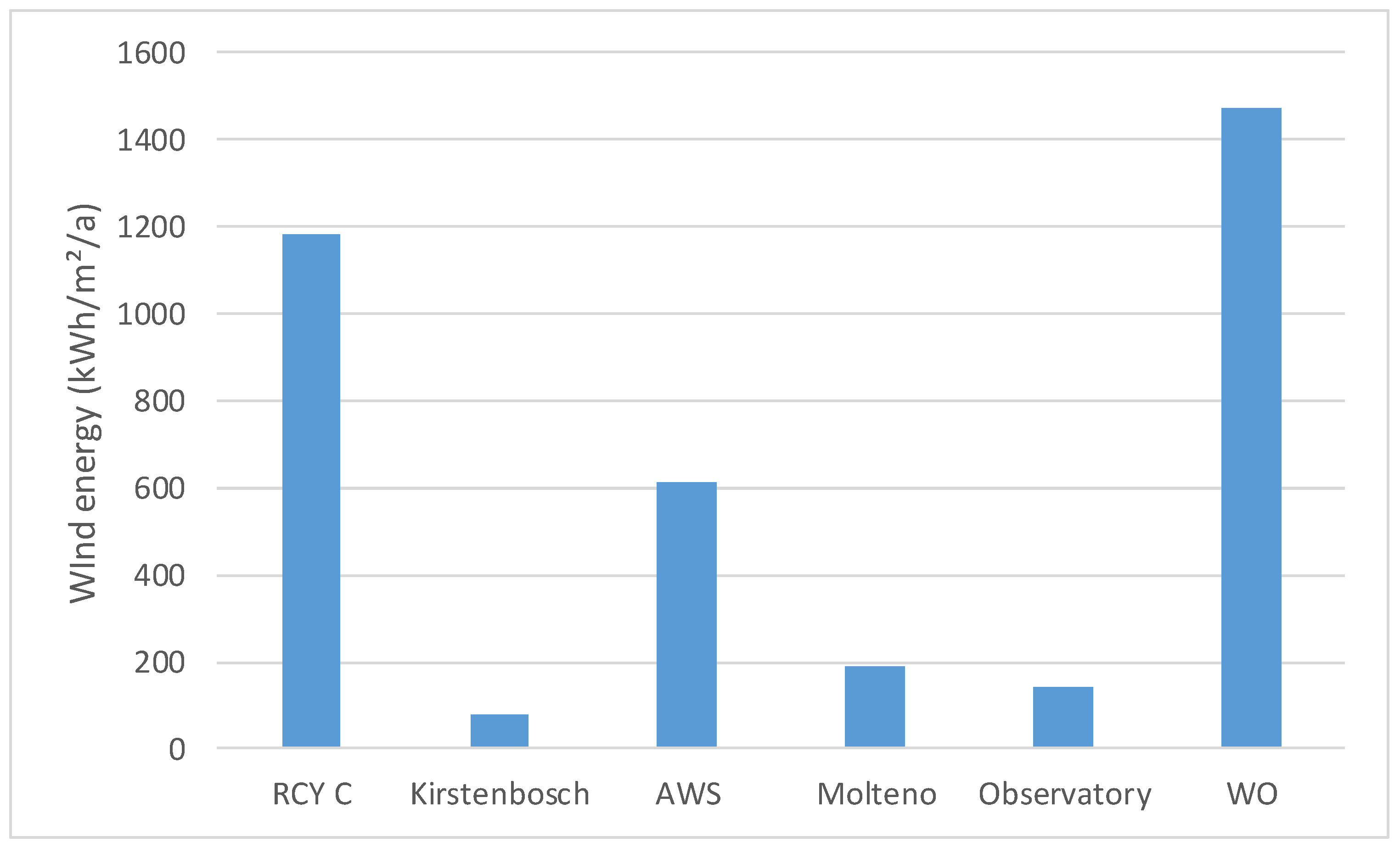
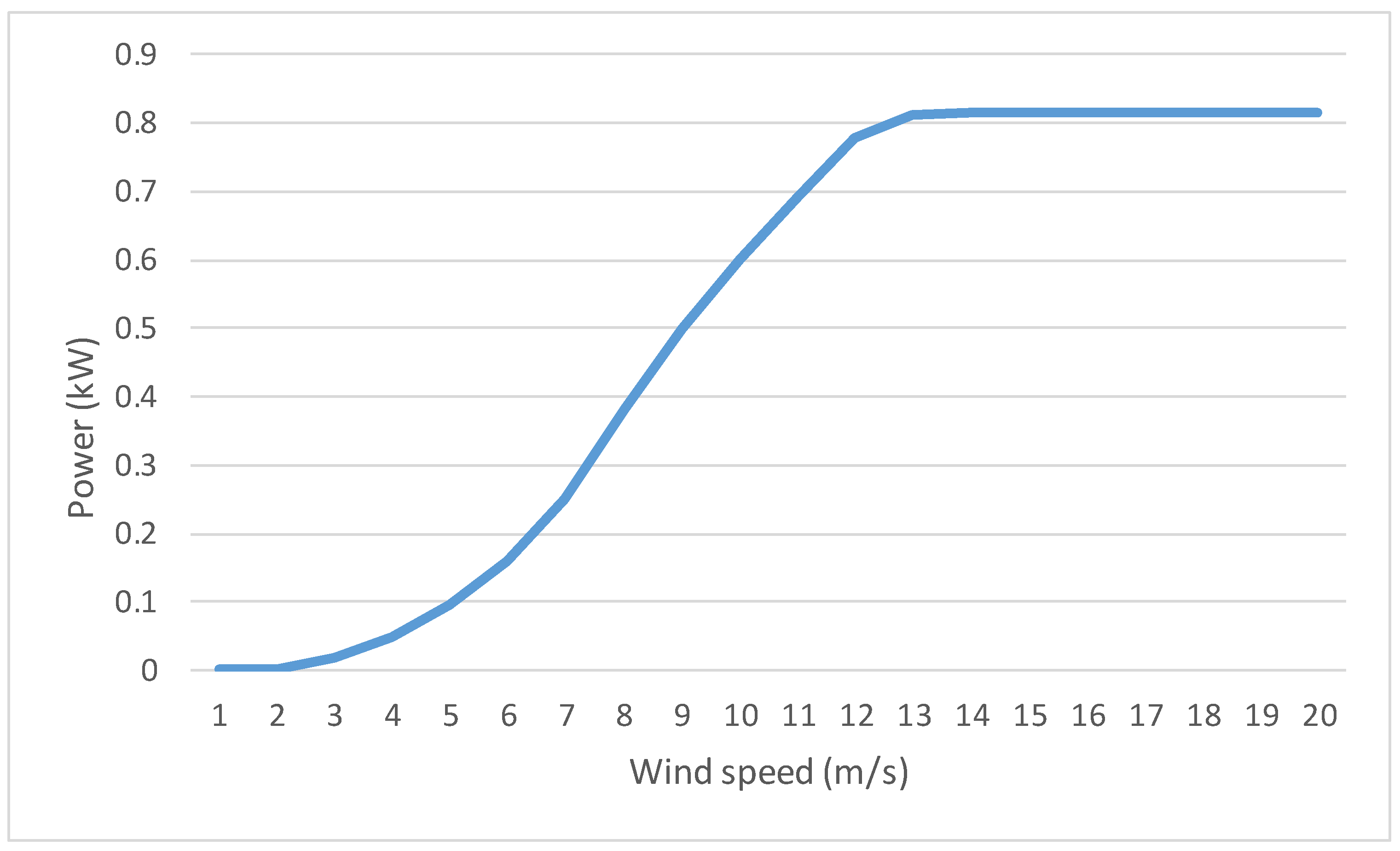
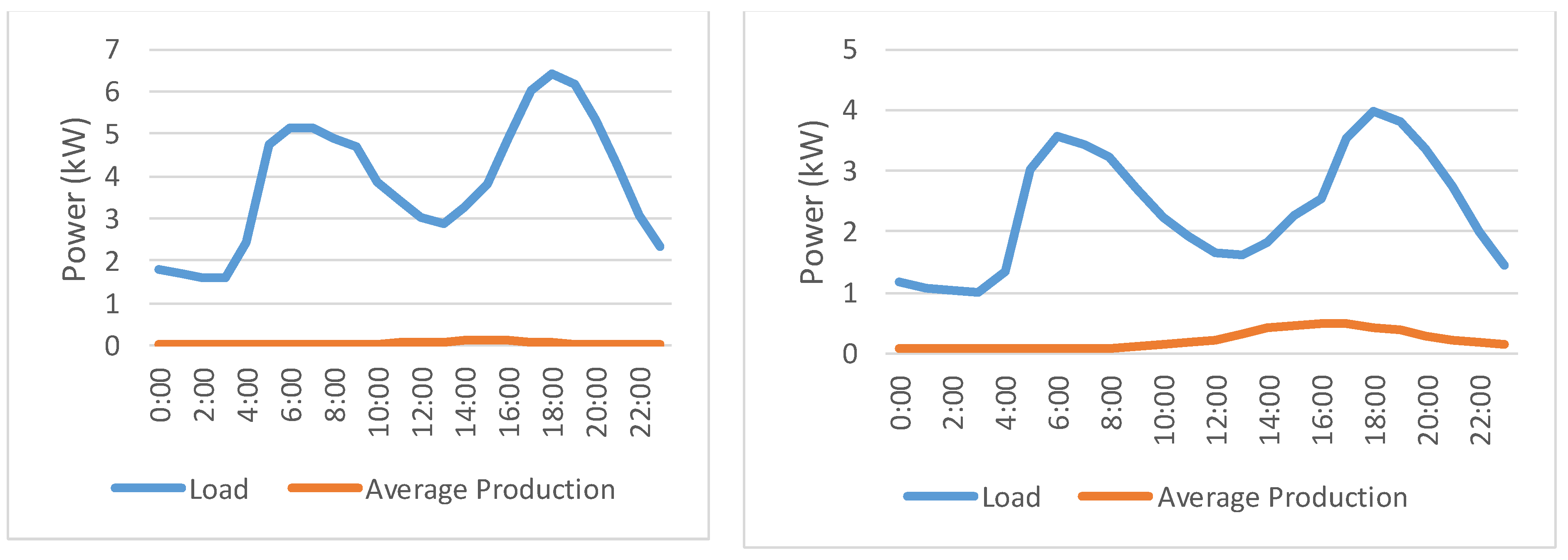
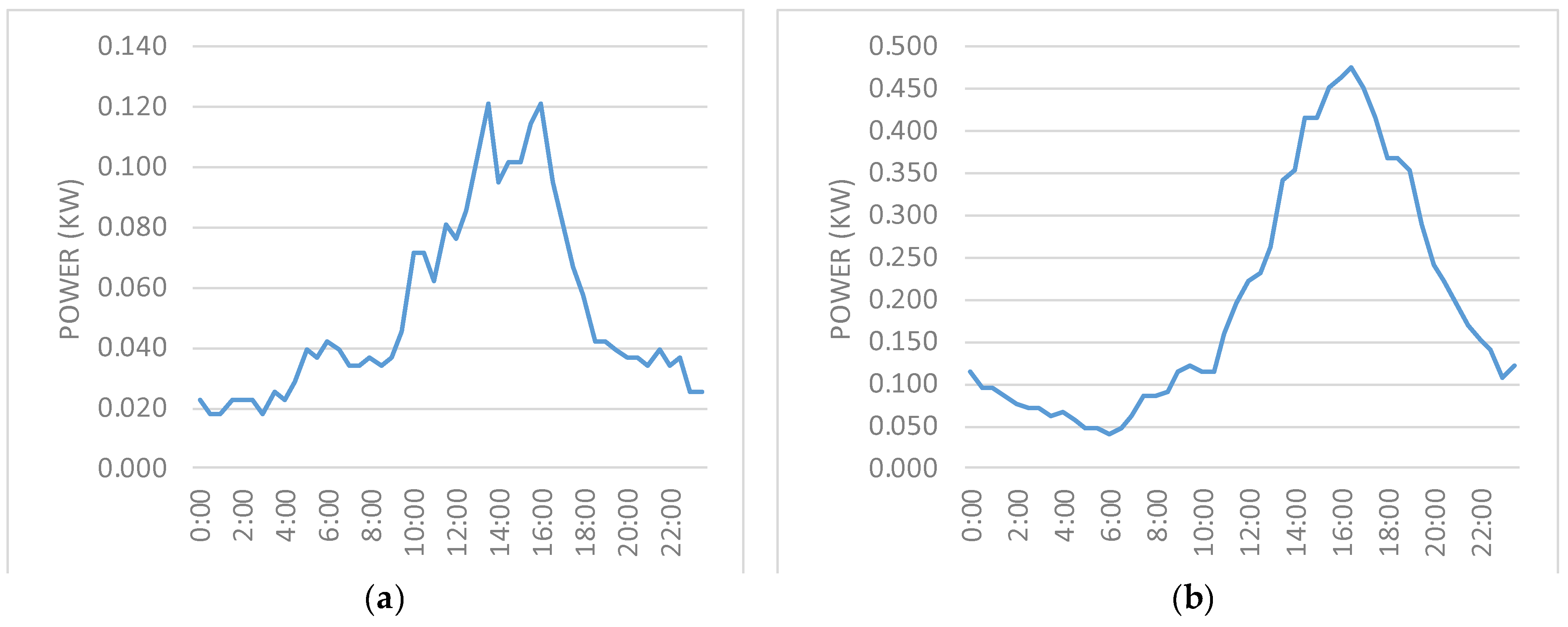
| Station Name | Location | Coordinates | Height Above Ground Level (m) | Data Logged (% out of 731 days) | Weibull Shape Parameter (k) | Weibull Scale Parameter (c) | Local Climate Zone Indicator |
|---|---|---|---|---|---|---|---|
| RCYC | Table Bay Harbor | 33°55′13.7″S 18°26′35.0″E | 12.1 m | 99.8% | 1.1 | 3.7 | G |
| AO | Observatory | 33°56′03.6″S 18°28′40.2″E | 9.1 m | 99.2% | 1.8 | 2.6 | 9 |
| KBG | Kirstenbosch | 33°59′14.9″S 18°25′57.0″E | 11.1 m | 100% | 2.2 | 2.3 | 6 |
| MR | Oranjezicht | 33°56′18.5″S 18°24′44.0″E | 9.4 m | 100.0% | 1.5 | 2.6 | 6 |
| AWS | Airport | 33°58′44.0″S 18°36′00.0″E | 9.8 m | 99.8% | 1.9 | 4.3 | D |
| CTWO | Airport | 33°57′46.8″S 18°36′07.2″E | 9.3 m | 99.8% | 1.8 | 5.7 | D |
| Turbine Name | Kestrel e230i | SkyStream 3.7 | eddyGT | Turby |
|---|---|---|---|---|
| Turbine type | HAWT | HAWT | VAWT | VAWT |
| Rated output (W) | 800 | 2 400 | 1000 | 2 500 |
| Rated wind speed (m/s) | 12.5 | 13 | 12 | 14 |
| Cut in wind speed (m/s) | 2.5 | 3.5 | 3 | 4 |
| Rotor diameter (m) | 2.3 | 3.72 | 1.8 | 2 |
| Number of blades | 3 | 3 | 3 | 3 |
| Swept area (m2) | 4.2 | 10.9 | 4.62 | 5.3 |
| Station | RCYC | Kirstenbosch | AWS | Molteno | Observatory | WO |
|---|---|---|---|---|---|---|
| Average wind speed (m/s) | 3.61 | 2.04 | 3.83 | 2.35 | 2.33 | 5.06 |
| Energy resource potential (kWh/m²/year) | 1181 | 80 | 610 | 189 | 145 | 1474 |
| Kestrel AEP (kWh/year) | 1224 | 19 | 982 | 259 | 199 | 1636 |
| Kestrel Capacity Factor | 0.172 | 0.003 | 0.14 | 0.036 | 0.028 | 0.229 |
| SkyStream AEP (kWh/year) | 3301 | 13.73 | 2401 | 518 | 339 | 4304 |
| SkyStream Capacity Factor | 0.155 | 0.001 | 0.11 | 0.024 | 0.016 | 0.203 |
| eddyGT AEP (kWh/year) | 784 | 4.33 | 523 | 119 | 85 | 975 |
| eddyGT Capacity Factor | 0.138 | 0.001 | 0.09 | 0.021 | 0.015 | 0.171 |
| Turby AEP (kWh/year) | 2406 | 0.659 | 1227 | 195 | 85 | 2730 |
| Turby Capacity Factor | 0.11 | 0 | 0.06 | 0.009 | 0.004 | 0.12 |
| Station | LCOE (Eur/kWh) |
|---|---|
| Royal Cape Yacht Club | 0.35 |
| Kirstenbosch | 22.59 |
| Automatic Weather Station | 0.44 |
| Molteno reservoir | 1.66 |
| Observatory | 2.15 |
| Cape Town Weather Office | 0.26 |
| Station | Electricity Generated (kWh/year) |
|---|---|
| Royal Cape Yacht Club | 1225 |
| Kirstenbosch | 19 |
| Automatic Weather Station | 982 |
| Molteno reservoir | 259 |
| Observatory | 200 |
| Weather Office | 1637 |
© 2019 by the authors. Licensee MDPI, Basel, Switzerland. This article is an open access article distributed under the terms and conditions of the Creative Commons Attribution (CC BY) license (http://creativecommons.org/licenses/by/4.0/).
Share and Cite
Gough, M.; Lotfi, M.; Castro, R.; Madhlopa, A.; Khan, A.; Catalão, J.P.S. Urban Wind Resource Assessment: A Case Study on Cape Town. Energies 2019, 12, 1479. https://doi.org/10.3390/en12081479
Gough M, Lotfi M, Castro R, Madhlopa A, Khan A, Catalão JPS. Urban Wind Resource Assessment: A Case Study on Cape Town. Energies. 2019; 12(8):1479. https://doi.org/10.3390/en12081479
Chicago/Turabian StyleGough, Matthew, Mohamed Lotfi, Rui Castro, Amos Madhlopa, Azeem Khan, and João P. S. Catalão. 2019. "Urban Wind Resource Assessment: A Case Study on Cape Town" Energies 12, no. 8: 1479. https://doi.org/10.3390/en12081479
APA StyleGough, M., Lotfi, M., Castro, R., Madhlopa, A., Khan, A., & Catalão, J. P. S. (2019). Urban Wind Resource Assessment: A Case Study on Cape Town. Energies, 12(8), 1479. https://doi.org/10.3390/en12081479








